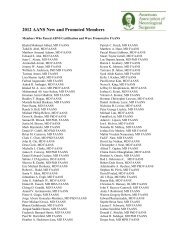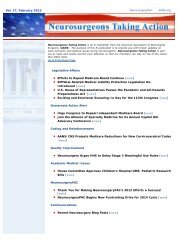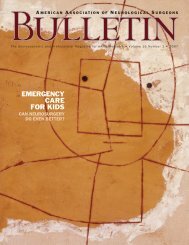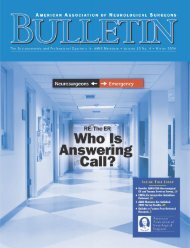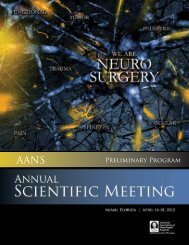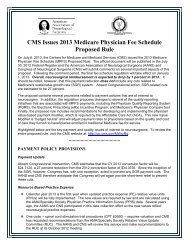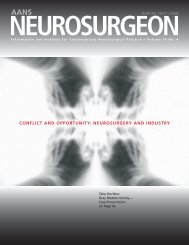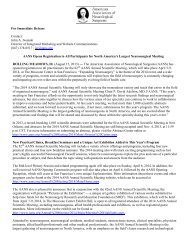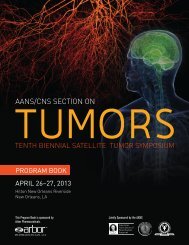view PDF - American Association of Neurological Surgeons
view PDF - American Association of Neurological Surgeons
view PDF - American Association of Neurological Surgeons
Create successful ePaper yourself
Turn your PDF publications into a flip-book with our unique Google optimized e-Paper software.
On The Cover: Time Tells<br />
FIGURE 6<br />
Operative Cases for Junior<br />
Total No. <strong>of</strong> Operative Cases in One Month<br />
Residents in One Month<br />
for Junior Residents<br />
TOTAL NO.<br />
60<br />
50<br />
40<br />
30<br />
20<br />
10<br />
0<br />
Primary Children’s<br />
Medical Center<br />
Univ. <strong>of</strong> Utah Hospital<br />
02-03 03-04<br />
ACADEMIC YEAR<br />
The total number <strong>of</strong> operative cases performed by all post-call<br />
junior residents during one month at Primary Children’s Medical<br />
Center was compared with the number at the University <strong>of</strong> Utah<br />
Hospital for the academic years before (2002–2003) and after<br />
(2003–2004) the ACGME guidelines became effective.<br />
Continued from page 21<br />
cover junior duties and allowing the junior residents<br />
to operate on less complicated cases.<br />
CHIEF<br />
Conclusions<br />
JUNIOR<br />
The ACGME restrictions on resident work hours<br />
represent a paradigm shift in the education <strong>of</strong> surgical<br />
residents in the United States. These new restrictions<br />
are likely to affect several issues, including<br />
patient care, resident training, resident health, and<br />
resident quality <strong>of</strong> life. This study addresses one<br />
aspect <strong>of</strong> resident training: the operative experience.<br />
At our institution, we have managed to comply with<br />
the 80-hour workweek at the expense <strong>of</strong> the operative<br />
experience <strong>of</strong> the junior residents. Any analysis <strong>of</strong><br />
the ACGME work hour restrictions will need to consider<br />
the impact <strong>of</strong> these regulations on several different<br />
aspects <strong>of</strong> resident training, such as number <strong>of</strong><br />
publications, board scores, and serial faculty evaluations,<br />
as well as on patient care. As additional objective<br />
data become available for assessing the impact <strong>of</strong><br />
the ACGME regulations, residency programs will<br />
need to be able to develop strategies to optimize the<br />
residents’ learning experience while maintaining<br />
high standards <strong>of</strong> patient safety. 3<br />
has increased to 21 per month. Less desirable<br />
options, which we have not implemented, include ACKNOWLEDGMENTS<br />
increasing the length <strong>of</strong> residency, decreasing the The authors thank Kristin Kraus for her assistance in preparing<br />
research training period, or having chief residents this manuscript for submission and publication.<br />
. . . . . .<br />
REFERENCES<br />
1. Barden CB, Specht MC, McCarter MD, Daly JM, Fahey TJ 3rd:<br />
Effects <strong>of</strong> limited work hours on surgical training. J Am Coll<br />
Surg 195(4):531–538, 2002<br />
2. Brasel KJ, Pierre AL, Weigelt JA: Resident work hours: what they<br />
are really doing. Arch Surg 139(5):490-493; discussion 493–494,<br />
2004<br />
3. Chandra RK: The resident 80-hour work week: how has it<br />
affected surgical specialties Laryngoscope 114(8):1394–1398;<br />
discussion 1319, 2004<br />
4. Cohen-Gadol AA, Piepgras DG, Krishnamurthy S, Fessler RD:<br />
Resident duty hour reform: results <strong>of</strong> a national survey <strong>of</strong> the<br />
program directors and residents in neurosurgery training programs.<br />
Neurosurgery 56(2):398–402, 2005<br />
5. Conyers JR: Patient and Physician Safety and Protection Act <strong>of</strong><br />
2001. H.R. 3236, 2001<br />
6. Corzine JS: Patient and Physician Safety and Protection Act <strong>of</strong><br />
2002. S. 2614, 2002<br />
7. Friedman WA: Resident duty hours in <strong>American</strong> neurosurgery.<br />
Neurosurgery 54(4):925–931; discussion 931–933, 2004<br />
8. Niederee MJ, Knudtson JL, Byrnes MC, Helmer SD, Smith RS: A<br />
survey <strong>of</strong> residents and faculty regarding work hour limitations<br />
in surgical training programs. Arch Surg 138(6):663-669; discussion<br />
669–671, 2003<br />
9. Underwood W, Boyd AJ, Fletcher KE, Lypson ML: Viewpoints<br />
from generation X: a survey <strong>of</strong> candidate and associate <strong>view</strong>points<br />
on resident duty-hour regulations. J Am Coll Surg<br />
198(6):989–993, 2004<br />
10. Whang EE, Perez A, Ito H, Mello MM, Ashley SW, Zinner MJ:<br />
Work hours reform: perceptions and desires <strong>of</strong> contemporary<br />
surgical residents. J Am Coll Surg 197(4):624–630, 2003<br />
22 AANS Bulletin • www.AANS.org



